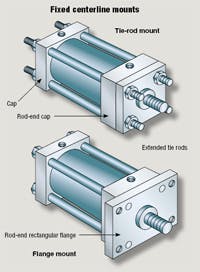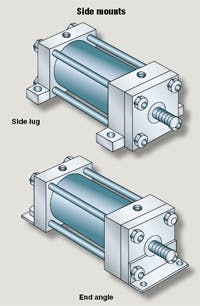No matter how good a hydraulic cylinder, poor mounting will hasten failure. Improper mounting can cause side loading, which destroys rod bearings and seals, or loosens hydraulic connections to cause leaks. In the worst cases, it can even cause pistons to bind or rods to buckle.
The National Fluid Power Association (NFPA) has standardized many dimensions for square-headed tie rod cylinders to promote cylinder interchangeability between manufacturers. Part of this standardization program includes cylinder mounting. Here’s a look at three main styles.
Centerline mounts
Fixed mounts on the centerline of the cylinder are considered best for straight line force transfer. A symmetrical configuration uniformly distributes thrust or tension forces from the piston rod about the cylinder centerline. Mounting bolts are subject to simple tension or shear without compound forces. When properly installed, centerline mounts minimize cylinder bearing sideloading. Among the different types:
Cylinder tie rods are designed to withstand maximum rated internal pressure, and can be extended beyond either end cap and used to mount the cylinder. When the tie rods extend at both ends of the cylinder, one end can be used to mount a cylinder and the opposite end for added support.
Flange mounts are one of the strongest, most-rigid mounting methods, though they have little tolerance for misalignment. Styles available f o r end caps include rectangular and square f langes , and l a rge r and thicker rectangular plates with their own mounting holes. Flange mount selection depends partly on loading. Experts recommend capend mount s for thrust loads and rod-end mounts where major loading puts the piston rod in tension.
Centerline lug mounts also absorb forces on the centerline, but they are probably the least popular fixed mounting style. When used at higher pressures or under shock conditions, dowel pin the lugs to the machine to prevent movement.
When using fixed mounts, travel path should be linear and guided if at all possible. If no misalignment is present at full retraction, fixed mounts can tolerate slight misalignment (typically 0.003 to 0.005 in. per foot of stroke) unless the cylinder has a large rod.
If high shock loads are anticipated, install the cylinder to take full advantage of its elasticity and hold fixed-mount cylinders in place by keying or pinning at one end only. Use separate keys to take shear loads — at the rod end if major shock loads are in thrust, at the cap end if they are in tension. Also keep in mind that rigidly connected fluid lines will be subjected to shock loads.
Locating pins may be used instead of shear keys to help take shear loads and ensure cylinder alignment. Avoid pinning across corners — this can cause severe twisting when a cylinder is subjected to wide temperature and pressure variations. Such twisting also affects fluid connectors at cylinder ports.
Side mounts
Cylinders with these mounting styles have lugs on the sides or ends of the end caps or side tapped holes for flush mounting. These mounts may be the easiest to use, but they should be well aligned and the load supported and guided for long service life.
Because the plane of their mounting surface is not through the centerline of the cylinder, side mount cylinders produce a turning moment under load. This moment tends to rotate the cylinder about its mounting bolts. If the cylinder is not well secured to the machine, or the load is not well guided, destructive side loads may be transmitted to the rod gland and piston bearings. To avoid this problem, side mount cylinders should have a stroke at least as long as the bore size. Heavy loading tends to make short stroke, large bore cylinders sway on their mounts, especially if they have side lugs, end lugs, and end angle mounts. Also, mounting bolts may be subject to increased tension in combination with shear forces.
Side mount cylinders depend on bolt strength and the friction of the mounting surfaces in contact with the machine to absorb the cylinder forces. The torque applied to the mounting bolts should equal the manufacturer’s recommended tie rod torque.
For heavy or shock loads, hold side mounted cylinders in place with a key or pins to prevent shifting. A shear key — consisting of a plate extending from the side of the cylinder — can be supplied with most cylinders, provided a keyway can be milled into a machine member. To absorb the major loading, maintain close tolerances (0.001 in.) between keys and keyways, and position the key at the rod end with the load in tension and at the cap end with a thrust load.
Side lug mounts are designed to let dowel rods pin the cylinder to the machine. When used, install pins on both sides of the cylinder but not at both ends.
Cylinders with offset mounts tend to change length and sway under load and temperature change, so tubing connected to a cylinder cap port will be subject to that resulting force and motion. If such a cylinder is rigidly plumbed, it will eventually leak. Offset mounts often require stronger machine members to resist bending, so also consider the rigidity of the machine frame.
Pivot mounts
Pivot mounts absorb force on the cylinder centerline and let the cylinder change alignment in one plane. They should be used when actuated loads travel through an arc or misalignment is a problem. Clevises, trunnion mounts, and spherical bearings are among the mounts that let a cylinder pivot during the work cycle, and they should be used with rod end attachments that also pivot.
Clevis and single ear mounts are usually an integral part of the cylinder cap and provide a single pivot for mounting the cylinder. Cap detachable clevis mounts are also available and most often used for air or medium-duty hydraulic service. Clevis mounts include a pivot pin of appropriate length and diameter to withstand the maximum shear load at rated cylinder operating pressure. Fixed clevis mounts are probably the most popular style and are used where the piston rod travels a fixed arc in one plane. They can be used vertically, horizontally, or any other orientation.
Clevis mounts are generally recommended for short strokes and small to medium bore cylinders. Long stroke thrust applications may require increasing the piston rod diameter to prevent buckling or using a stop tube to minimize cylinder side loading when fully extended. Fixed clevis mount cylinders do not function well if the rod’s travel path is in more than one plane. Such applications cause misalignment and unnecessary side loading on the bearing and piston. If the piston rod travel path is not more than 3° either side of the true plane of motion, use a cap spherical bearing mount as well as a spherical bearing rod eye.
Trunnion pivot mounts fixed to the rod or cap end or an intermediate position are available, as are special trunnion assemblies that provide gimballing action. Trunnion pins are designed only for shear loads and should not be used with bending stresses. Support bearings should mount as close as possible to the trunnion shoulder faces.
Rod end trunnion mounted cylinders usually can have smaller diameter piston rods than equivalent cylinders with the pivot point at the cap end or an intermediate position. On rod-end trunnion mounted long stroke cylinders, consider the overhanging weight at the cap end of the cylinder and provide added support, if necessary.
Intermeidate trunnion mounts are often recommended for long stroke and heavy cylinders. They should be located near the balance point at maximum stroke — generally about 13 of the distance from the rod end cap. However, trunnion location must be specified at time of order because it cannot be easily changed once manufactured.
Simple, pivoted centerline mounts, such as a clevis or trunnion, compensate for single-plane misalignment. If multiple-plane misalignment is encountered, the cylinder should have self-aligning ball joints on the cap and rod ends of a clevis mounted cylinder — and fluid line connections should accommodate the movement.




